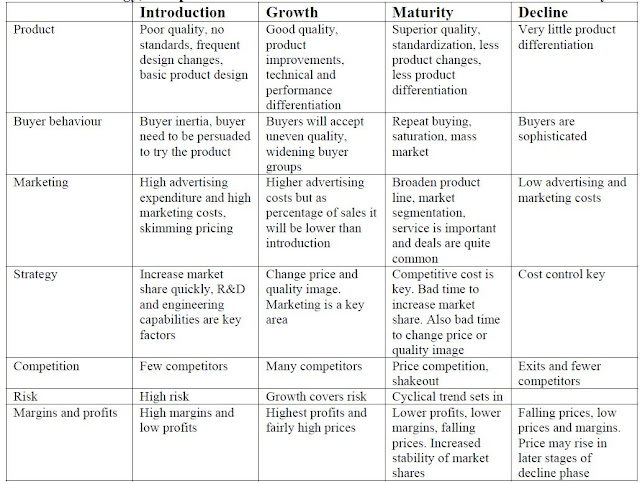
which changes will occur in the future. Given the importance of predicting the business environment accurately, it is desirable to have a robust technique which will help in anticipating the pattern of industry changes that one can expect to occur.
One of the most well-known and reliable tools for predicting the probable course of events in the future is the product life cycle (PLC) concept. The basic hypothesis of this concept is that an industry passes through a number of phases starting with introduction followed by growth, maturity and decline phases. Product life cycle theory predicts that industry growth follows an S-shaped curve because of the process of innovation and diffusion of a new product.
The introduction phase is often characterized by a flat curve reflecting the difficulty of overcoming the buyers’ inertia and their initial reluctance to try unknown and untested product. However, the product enters a rapid growth phase once the product proves successful.
This rapid growth phase reaches a plateau once the product reaches all the potential buyers. This phase is called the maturity phase.
In the final phase of the product life cycle the growth tapers off and the demand for the products starts declining as new substitutes start appearing in the market.
The predictions of product life cycle theory about the strategies, competition and performance are explained in the table below.
 |
| Strategy, Competition and Performance in Different Phases of Product life Cycle |

describe one pattern of evolution which will invariably occur. And except for the industry growth rate, there is little or no underlying explanation provided by this concept as to why the competitive changes associated with life cycle will happen. Moreover, the industry evolution can have so many different paths, the life cycle pattern may not always hold good. Nevertheless, the PLC is a robust model of industry evolution and it predicts the strategy, competition and the performance of a firm in different business environments.
Generally, industries which have products in the introduction and growth phases operate in a dynamic environment, while those with products in the mature phase operate in a more stable environment. The stable and dynamic industry segments differ from one another due to the difference in speed and direction of the following industry dimensions:
- Long-term changes in growth
- Changes in buyers’ segments
- Buyers’ learning
- Diffusion of proprietary knowledge
- Product innovation
- Marketing innovation
- Process innovation
- Government policy change
- Entry and exit of competitors

A good understanding of all the above dimensions that can shape the industry dynamics will assist a firm to face and in some cases even influence the structural changes. A firm’s ability to predict the future events will provide a valuable head start to direct environmental forces in ways appropriate to the firm’s position. In fact, successful firms do not view environment change as fait accompli, to adjust to, but as an opportunity.
Industry environments vary in their basic strategic implications along a number of important dimensions, namely:
- Industry concentration
- State of industry maturity
- Exposure to international competition
The following sections will discuss the industry environment and the strategies based on these dimensions. In addition, in each of these environments, the structure of the industry, strategic issues and strategic alternatives are also discussed. Two important business environments are selected for discussion, namely dynamic environment characterized by very dynamic changes and stable environment typified by steadier and stable variations.
Be the first to comment on "Concept of Product Life Cycle"